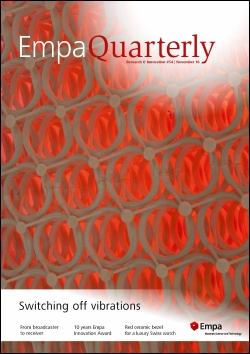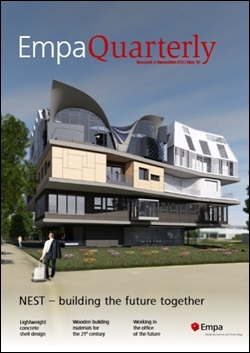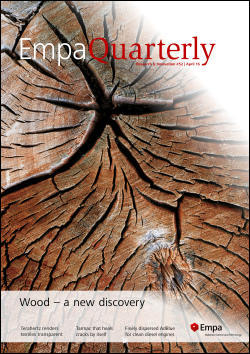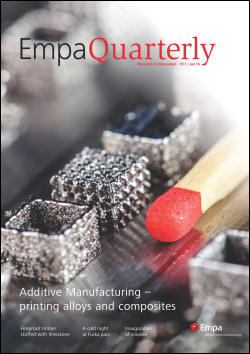EmpaQuarterly 2016
Switching off vibrations
Macroscopic crystal structures can absorb unwanted vibrations or filter noise – without any electronics or electricity whatsoever. They can be lighter and more solid than previous conventional insulating ma-terial and can even be tailored to their intended purpose. Is acoustics on the brink of a revolution?
The Empa Innovation Award
When Empa presented its first Innovation Award back in 2006, no-one could have imagined everything that followed. Today, the prize is regarded as an honor en route to scientific success. This year, ten groups of researchers have applied for the coveted accolade. But how successful have the previous winning projects been? Time to look back.
On May 23, 2016, the modular experimental building NEST was inaugurated on the campus of the two research institutions Empa and Eawag in Dübendorf. NEST is a living lab aimed at accelerating the innovation process in the building and energy sector. More than 90 partners from research, industry and the public sector will be joining forces at NEST to develop sus-tainable technologies, materials and systems, and test them under real conditions. The current issue of EmpaQuarterly is dedicated entirely to this prestigious project. For more information please visit the NEST webpage.
Wood: probably one of mankind’s oldest building and handicraft materials. Versatile, aesthetically appealing and renewable, it is one of the few natural raw materials that Switzerland has in spades. So far, so good. But so tedious. After all, we know virtually everything there is to know about wood, don’t we? Far from it, actually – especially when it comes to the wood processed in Empa’s labs. The Focus section in this issue of EmpaQuarterly reveals just what these novel high-tech types of wood can do. We already reported on wood that no longer burns in the past. But how about wood with an antimicrobial quality, i.e. it kills germs. We also demonstrate how wood can be rendered so waterproof that it can even be used to make sinks or bathtubs. A magnetic board made of wood? No problem either, thanks to embedded iron oxide particles.
The next industrial revolution is imminent. It‘s called ‘Industry 4.0’ and is expected to fundamentally change the production methods used in industrialized countries. A key component in making Industry 4.0 a reality are machines that can produce the desired components faster, more flexibly and more precisely than ever before. Less prototype construction, fewer dies, less post-processing. In future it will have to be possible to turn data into components and products at an incredible speed. 3D-printers, capable of handling metal powder, will make that possible. In this issue, we present the challenges that need to be overcome in the development of 3D printing of metal parts – along with the significant opportunities that this technology offers. Empa is working on this topic with a number of research groups.

Empa Quarterly
Want to subscribe to our magazine? It's easy, simply click here.
Archive
Do you want more stories from Empa's labs? Check out previous issues of the magazine below.





